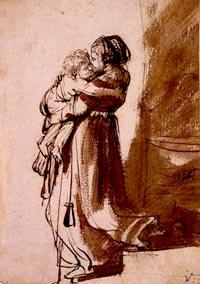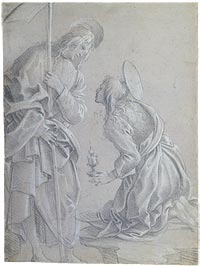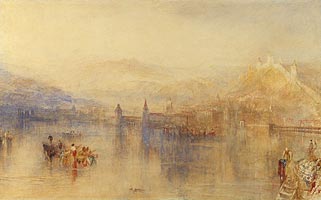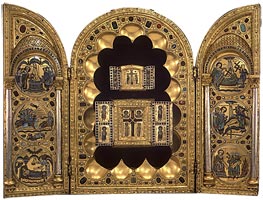The Morgan's collection of drawings numbers about 10,000 sheets, including several thousand drawings bound in sketchbooks and albums. The collection's primary focus is European drawings executed before 1825, but the Morgan's holdings include a growing number of nineteenth- and twentieth-century works 
Rembrandt Harmensz. van Rijn,
Woman Carrying a Child Downstairs.
Acc. no. I, 191 on paper as well as drawings by American artists. The Morgan has about 13,000 prints, including the largest and most representative collection of Rembrandt etchings in this country. The Morgan also owns about two hundred art objects.
Collecting History
In 1910 Pierpont Morgan established the core of the Morgan's holdings when he purchased a collection of about fifteen hundred old master drawings from the English artist-collector Charles Fairfax Murray. Fairfax Murray's was the first great European drawings collection to find its way to this country, and its strengths—notably sixteenth- and eighteenth-century Italian drawings and Netherlandish drawings of the sixteenth and seventeenth centuries—remain unsurpassed in the United States.
Following Pierpont Morgan's death in 1913 and the founding of the Morgan by his son in 1924, the Morgan did not begin to collect drawings actively until 1947. The most important factor in the growth of the collection since that time has been the acquisition of individual works and entire collections through gift and bequest.
Notable among these was the gift of the collection of Mrs. J. P. Morgan, Jr., which was presented to the Morgan by her sons Henry S. and Junius S. Morgan. The gift included more than five hundred architectural and garden designs as well as a large series of drawings by Giovanni Battista Piranesi. In 1973 the noted cellist and connoisseur Janos Scholz announced his gift of some fifteen hundred Italian drawings, thereby enriching the Morgan's already extensive holdings of sheets by Italian draftsmen of the sixteenth to eighteenth centuries. 
Filippino Lippi, Kneeling Saint Mary
Magdalene and Standing Christ for a Noli
Me Tangere Composition. Acc. no. 1951.1 In 1975 Eugene V. and Clare E. Thaw announced that their collection of drawings and watercolors, the finest in private hands in this country, would be given to the Morgan in stages during their lifetime. Over a number of years, the gift of a small but choice selection of drawings by Trustee Otto Manley enriched the holdings of various schools and added the Morgan's first sheet by Leonardo da Vinci. In 1996 and 1997, Mrs. Rudolf J. Heinemann's gift of more than a hundred sheets by Giovanni Battista and Domenico Tiepolo secured New York's position as this country's preeminent center for the study of Italian drawings.
The Morgan's collection also is strong in drawings for the theater. More than sixteen hundred theatrical drawings, mostly stage designs from the seventeenth through twentieth centuries, were given to the Morgan in 1982 by Mrs. Donald M. Oenslager, the widow of collector and theater designer Donald M. Oenslager.
Italian drawings comprise about 2,600 individual sheets as well as a significant number of sheets bound in albums and sketchbooks, including works by Raphael, Michelangelo, and Leonardo da Vinci. The Morgan's important collection of albums and sketchbooks includes the Codex Huygens, a well-known copy of Leonardo's lost manuscript on human proportions.
French drawings comprise more than seven hundred individual sheets, and a number of albums and sketchbooks. Pierpont Morgan was influential in the heightening of American taste for French art at the turn of the nineteenth century. His collection included drawings by Claude Gellée, called Claude Lorrain; François Boucher; and Jean Antoine Watteau. Since then, works by J. A. D. Ingres, Théodore Géricault, Jean François Millet, Edgar Degas, Paul Cézanne, Paul Gauguin, and Henri Matisse have strengthened the Morgan's holdings in works by nineteenth- and twentieth-century draftsmen.
British drawings comprise nearly nine hundred individual sheets as well as albums and sketchbooks. In 1903 Morgan acquired William Blake's watercolor illustrations to the Book of Job; in 1949 the Morgan acquired Blake's illustrations for Milton's poems L'Allegro and Il Penseroso. William Hogarth, Thomas Gainsborough, Henry Fuseli, Thomas Girtin, J. M. W. Turner, John Constable, 
J. M. W. Turner, Lucerne from the Lake. Acc. no. 1996.148 Edward Burne-Jones, and William Morris are only a few of the distinguished draftsmen represented in the collection.
Netherlandish, Flemish, and Dutch drawings number about 730. The collection includes about 620 drawings by Netherlandish and Dutch artists of the fifteenth, sixteenth, and seventeenth centuries and about 110 Flemish drawings, principally from the seventeenth century. Among the works are sheets by Hendrick Goltzius, Jacob Jordaens, Rembrandt Harmensz. van Rijn, Peter Paul Rubens, and Anthony van Dyck.
American drawings comprise about five hundred individual sheets and a modest number of sketchbooks. The Morgan contains the largest single collection of the drawings of Benjamin West as well as a substantial group of drawings by his son Raphael Lamar West. Other American artists represented in the collection are John James Audubon, Henry Farrer, and H. Siddons Mowbray.
German drawings comprise more than one hundred fifty individual sheets, in addition to albums and sketchbooks. The collection includes eight sheets by Albrecht Dürer, one a study for Adam and Eve. Other German artists represented in the collection are Tobias Stimmer, Wenceslaus Hollar, and Caspar David Friedrich.
Architectural Drawings and Views
Through the gift from Mrs. J. P. Morgan, Jr., the Morgan acquired the largest single collection of drawings by Giovanni Battista Piranesi and a large number of architectural designs for English houses, including Packington Hall. From the collection of Paul Mellon, the Morgan received a Roman architectural sketchbook dated 1513 and attributed to Menicantonio, an assistant of Bramante.
Sketchbooks and Albums
There are about eighty sketchbooks or albums in the Morgan's collection. Two outstanding examples are a sketchbook of Paul Cézanne used mostly during the decade 1875-85, and a Roman sketchbook by Hubert Robert, the most prolific and best-known landscape painter of eighteenth-century France. Among the treasures of the Morgan's collection of botanical drawings are a group of flower portraits by Pierre-Joseph Redouté and the charming European travel sketchbooks by Jane Norton Grew (Mrs. J. P. Morgan, Jr.)
Prints
The extensive series of Rembrandt drawings in the Fairfax Murray collection admirably complemented the etchings by the artist already in Morgan's possession. In 1900 Morgan acquired the collection of Theodore Irwin, numbering 272 sheets; in 1905 negotiations began for the purchase of 112 etchings from the collection of George W. Vanderbilt. J. P. Morgan, Jr., continued to add to the collection; later acquisitions have brought the number of Rembrandt etchings to 489.
The Peel Collection, which contains more than 3,300 political caricatures, broadsides, and portraits, is one of the outstanding collections of such material. It was assembled by Sir Robert Peel (1788-1850) and sold to Pierpont Morgan in 1900. The prints range in date from 1642 to 1830, documenting political history from Cromwell to George IV. Lithographs, engravings, woodcuts, and mezzotints, some of which are hand colored, are included in the collection.
The twenty-one volumes entitled Engraved British Portraits contain nearly eight thousand prints, most of which date to the eighteenth or early nineteenth century. The collection of fashion prints consists of 391 examples from the seventeenth and eighteenth centuries. Most are mounted, hand-colored extracts from published albums. Thirty-two of the plates are "dressed" or decoupés, created by cutting out portions of the print and facing them from the reverse side with fabric. The collection of dressed prints is one of the finest in this country.
Art Objects

Stavelot Triptych. Flemish, mid-twelfth centuryThe paintings and art objects that remain in the Morgan were with a few exceptions acquired by its founder, Pierpont Morgan. After his death, most of his original collection was given away or sold by his son, J. P. Morgan, Jr. The chronological span of the remaining works is impressive, from early Mesopotamian through medieval, Renaissance, and baroque. The Stavelot Triptych, a reliquary for the True Cross, is the single most important art object in the Morgan. Other noteworthy items include the twelfth-century Malmesbury Ciborium, a sixteenth-century wooden statue of St. Elizabeth of Hungary, and Hans Memling's Portrait of a Man with a Pink.
CORSAIR, the Morgan's online collection catalog, is available here.
